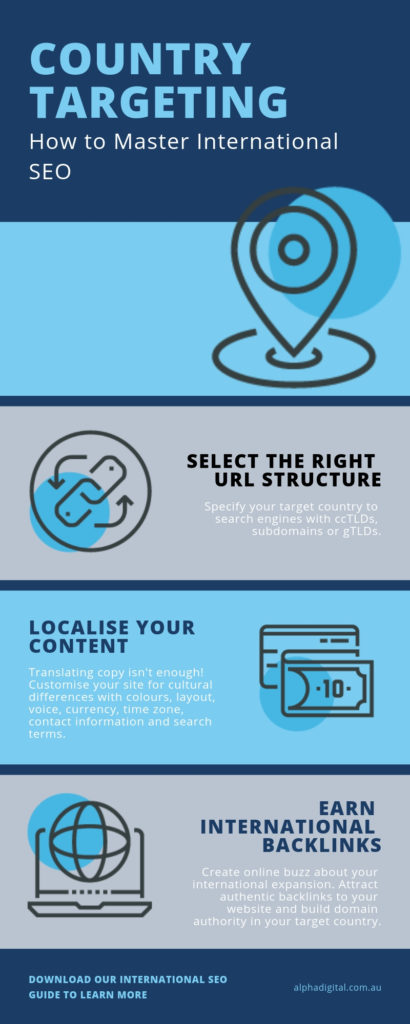How to Master Country Targeting and International SEO
So, you’re ready to take your business overseas? Building an online presence internationally may well be one of your first hurdles.
Here we break down country targeting and international SEO – two crucial factors in your (world domination) success.
What is international SEO?
International SEO is the process of helping search engines to quickly determine your target country and chosen language. You need to use international SEO to ensure that your website shows up in local listings and is culturally optimised to drive conversions.
What is country targeting?
Country Targeting (aka. geo-targeting) is where you focus in on targeting your country specifically. A major step is creating the correct URL structure to specify your target country with search engines.
Why is country targeting important?
Country targeting is an important step in international SEO because it helps you to:
-
- Improve website rankings
-
- Target audiences with the most relevant content and keywords
-
- Target local rankings with less competition
- Build trust with your international audience
How to set up country targeting:
1. Create the URL structure:
Country targeting can be set up with ccTLDs. A ccTLD is a country specific top-level domain. In a nutshell, ccTLDs include country codes like .com.au for Australia.
In the following examples, the ccTLDs are bolded:
-
- http://www.yourwebsite.fr (France)
- http://www.yourwebsite.co.uk (United Kingdom)
ccTLDs are the strongest way to show search engines and users that your website is specifically targeted to a specific country or region. When search engines see your ccTLD they know what geographic area your content is targeted to. They’re also a quick way for international users to check that your website is meant for them.
However, there are some cons to ccTLDs.
Let’s say you have a French and an Australian website, with the following two ccTLDs:
-
- http://www.yourwebsite.fr (France)
- http://www.yourwebsite.com.au (Australia)
Search engines will consider these as two separate sites. Therefore, any domain authority or SEO value that you have already built on your Australian website will not be shared to your French website.
The authority of each website needs to be built up separately. While ccTLDs send strong targeting signals, they can be time-consuming and costly.
Check out our International SEO Guide to learn more about other domain structure options such as subdomains and gTLDs.
2. Localise Your Content
Translating the copy on your international website isn’t enough!
If your website isn’t customised for cultural differences, international users are unlikely to convert. Each country will require unique colours, layout and tone of voice to suit their cultural norms. Imagine if you came across a website with the wrong currency – it’s very unlikely you would want to make a payment through the site.
International users will also search differently. Be sure to do your keyword research in your target region to find out what people are searching for overseas. Then, plant these keywords strategically throughout your site.
Also remember to choose the right time zone, address and phone numbers for your target country.
Localised content is clearly more than words. Use all these factors together to send strong signals that your website belongs in your target country.
3. Earn International Backlinks
As we mentioned, you will need to build up domain authority in your target country. A great way to do this is to create some online buzz around your website. Reach out to local publishers and let them know about your expansion into the country.
The PR outreach can create authentic backlinks to your website.
This will send quality traffic to your website and build your online credibility. Search engines will see your site as more authoritative and relevant when you have more links with other websites in your target country.
The next step to consider in your international SEO strategy is language targeting. If you’re ready to learn the ins and outs (while getting friendly with HREFLANG tags) then download our comprehensive International SEO Guide.
